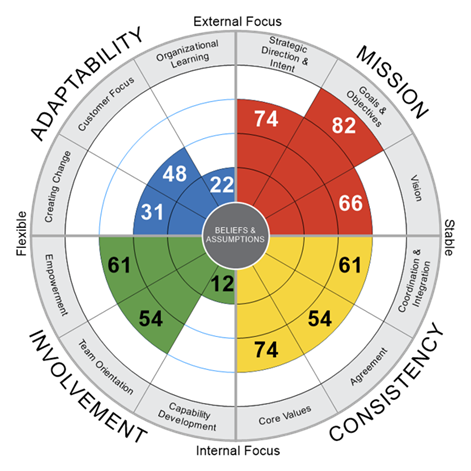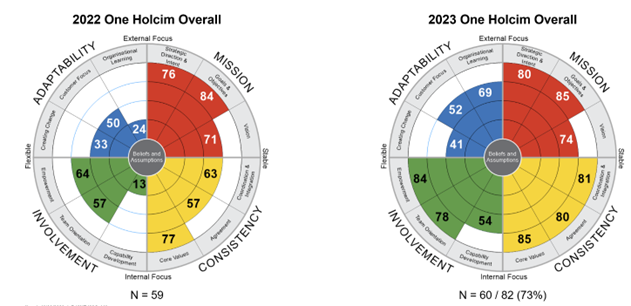
Holcim Trading
Working in Partnership – Is It Worth It?
We believe it is. We want to share our experience of a partnership because we believe it is truly innovative.
Daniel B, Strategic Enterprise Transformation Consultant at CoachHub, states how excited he was when he met Karen Jones, Managing Director of Consulting and Partnerships at Denison Europe, and discovered that organisational culture transformation could be tangible, with data behind the dialogue. This was exactly what he was looking for, to amplify the impact of the programs he ran with his clients at CoachHub.
Coach Hub is a digital coaching provider and much more. They are a transformation partner with over 3,500 coaches in more than 70 countries and 60 languages. They can truly support behavior change at scale. CoachHub supports over 1,000 clients globally and has been the global coaching provider of Holcim since 2020 and has coached hundreds of employees across 40+ countries. Their expertise is clear in the provision of coaching, but when it comes to change initiatives, they often challenge their customers with the questions:
- What are we developing people for?
- What are the required behaviors, competencies, and of course, most essentially, what is the desired purpose?
- Who are we engaging in the process?”
A while back, Daniel discovered the powerful service Innovisor, a firm that helps companies answer the most important question about who to engage in change efforts. They use network analysis to really identify individuals within a company who are seen as informal influencers. Informal influencers are considered those with the greatest reach because of how they are seen by others. They can create connections within the company, and potentially scale the desired behavior. Innovisor enables companies to identify these individuals.
Karen shared Daniel’s excitement when she discovered what Innovisor could add to the culture contribution. To discover those in a company that have the greatest reach, in terms of informal influence, was a powerful contribution to the usually more leadership-led approach.
Denison Consulting is a company that specialises in diagnosing company culture to create powerful dialogue that leads to co-created change, so to include those most likely to influence the general workforce felt inspiring.
CoachHub, Innovisor, and Denison now only needed the most important partner of all: the client. Daniel positioned an idea to them:
“How about piloting the diagnostic of your culture across your business units and levels, discovering your informal influencers, and providing coaching to both your senior leaders and informal influencers, to ensure they bring their best selves to the whole process?”
And the story begins…
Celine Da Costa Coimbra started as CEO at Holcim back in Jan 2021, mid-pandemic. She found a company very divided, struggling post-merger of two giants, who for seven years remained poorly integrated. “Them” and “Us” was strong, a common question would be “Which colour are you?” Celine could see and hear the persistent “clash of clans.” Her arrival was not welcomed, and her management team was not supportive. She had two and a half months to come up with a new strategy.
She interviewed every single person (80) in the company to try to understand the business and see what could be improved. She wanted to see what they were doing right and where the focus for the future strategic priorities should be placed. As the new CEO, the time to interview all 80 people was hard to find, so she ran a short survey instead, entitled “Getting to Know Trading.” What she discovered was extremely interesting – she learned no one was clear about the strategy. Some employees even asked, “Do we have one?”
Her second revelation was that the culture was toxic. There was a power separation between some of the top management and the rest of the organisation. There was unacceptable behaviour in the office, with a fear of getting fired for just raising your hand.
As the company evolved during this first year, quite a few organisational changes were made:
- The whole HR team was changed.
- The new strategy was presented to the exco members and was approved.
- They organised ‘strategy days’ with the entire company, virtually, of course, because this was still Covid times. This gave everybody the chance to listen to the new strategy and to understand what the future might look like.
When Celine first presented the idea of sharing the strategy company-wide, her own leadership team was shocked. They responded with, “What do you mean, we are going to tell the strategy to every employee?”
Whilst she had gained a lot from her first self-made survey, she wanted to professionalise the process and go deeper into the perceived issues and opportunities across the business. She wanted to include everyone to elevate the standards of the organisation towards not only a better culture but a much healthier environment that reflected the high performance required.
They have indeed had an incredible performance over the past two and a half years, despite the war and other severe disruptions in the market. Celine believes:
“That if people are really engaged, involved in the journey, feel part of a collective team they become stronger, and reach higher performance.”
Their first culture diagnostic was run in 2022 (see below for their baseline score).
2022 One Holcim Overall

N = 60
The effort that had gone into clarifying the strategy and where they were heading had paid off. The big opportunities were:
- How to become more coordinated & integrated.
- How to improve communication and inclusion overall.
- Understanding which capabilities they needed to reinforce in their team.
- Reflecting on their process for reflection and organisational learning.
The diagnostic enabled the data to be explored from different perspectives: level, department, location, and tenure.
The Senior Leadership Team wanted to prioritise three elements for concerted effort in phase 1: How we communicate, recognise, and give feedback to each other. This was felt to be the foundation that would enable capability development and collaboration to be enhanced across the regions. Being capable of powerful communication and indeed, listening, would drive both empowerment and the accountability that went with it.
With the support of Innovisor the people who were perceived by the employees as informal influencers were discovered. They are now referred to as the ‘People Ambassadors’ because they are the people who others go to.
When looking to change or transform culture, one tends to work with those who are more positive and willing to change. Some of the people identified were those more likely to challenge current practices. This public recognition seemed to have a good impact on them, inviting them to be at their best. Some were very surprised to be seen in this way by others:
“I don’t think I’m the right person, you know there must be confusion here.”
There was a recognition that support should be provided to enable this transition to bring value to them and to their role. Both the People Ambassadors and Management team received coaching from CoachHub, with more than 140 coaching sessions completed.
Each Ambassador could choose the priority they felt they had more energy and enthusiasm for:
- “I would like to work on in the pillar of recognition.”
- “I’m good teaching technical products, I can work on the Training Academy.”
- “I would like to work on the road shows, talking to the people about these changes.”
People were empowered and did not have to wait for permission. The message was, “These are the opportunities – make the most of them.” There was more face-to-face interaction, quick check-ins on goals, and progress. How people communicated with each other became a key measure of improvement. There was a constant promotion of a sense of empowerment and collaboration.
A common theme that was voiced was the desire for development. People wanted to learn more about technical products and develop their own development plans.
There was a realisation that clarity was required around some behaviours, like when emails were sent, it is not OK to expect an instant reply. There was greater definition around the agreed “ways of working.”
The company worked in a global way, so this gave another challenge to driving a collective way of working. There was an investment in bringing everyone together once this became possible post-Covid. There was public recognition of these events in the form of internal awards.
The progress that had been made (see data below) in their second culture diagnostic can be clearly below.
This time, the People Ambassadors were invited to:
- Debrief the data together with the management team. They were able to share with the Management Team what they felt needed to be done.
- They in turn shared the data with their teams, without the management team present. As they felt empowered, they began to empower others.
- There was a real desire to hear from those close to the operations where they felt the focus should go.
- What was more relevant for them, if we are all to grow and progress to the next level.
Celine would be the first to say that she needed to hold her own vulnerability within this ‘new’ process. She acknowledged publicly how hard it can be to deal with feedback and constructively move forward from it. She discovered when she pulled her management and People Ambassadors together that the discussion was extremely positive. It created a sense of engagement and trust. It seemed to create real clarity on why this process was so inclusive. Anyone who had seen it as a ‘tick the box’ initiative was now convinced it was about driving an inclusive action plan.

Céline stated: “I’m very proud of this progress. When I looked at it, I’m like wow! Have we done all of this in a year?”
“The ‘People Ambassadors’ were not necessarily the people who were seen as promoters, and some were pretty vocal about what was going wrong in the company. This made the progress seem even more significant, seeing the People Ambassadors take their leadership role at Davos.”
Some of the results they were happy to accept, such as those around customer focus: Some customers want 180 days payment terms, and this was never going to happen, so the discussion needed to happen.
“The process unmuted the discussions…This is so rich and a little bit scary, I have to say sometimes, but has enabled us to move forward so much faster. And again, financially speaking, our results are amazing.”
People are now volunteering to be new People Ambassadors. They have their own committee and are designing the process for 2023, defining the pillars to be focused upon. Coaching continues. With the addition of a programme created by Heather Hansen – the unmuted programme.
Celine recognizes that “there’s still a lot to be done and to be pursued but we are doing this together now…I’m very thankful also to have had every one of the partners who have helped us channel and professionalise our process. It was also powerful to have data-driven decisions as well, and the ambassador concept is pretty cool.”


